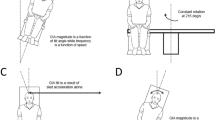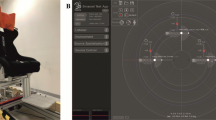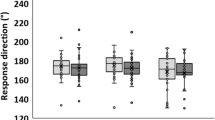Abstract
The tilt–translation ambiguity occurs because acceleration due to translation cannot be differentiated from gravitational acceleration. Head tilt can occur independent of body tilt which further complicates the problem. The tilt–translation ambiguity is examined for fore-aft (surge) translation with head and/or body orientations that are tilted in pitch 10° forward or backward. Eleven human subjects (six female), mean age 40 years participated. Conditions included no tilt (NT), head and body tilt (HBT), head only tilt (HOT), and body only tilt (BOT). The fore-aft stimulus consisted of a 2 s (0.5 Hz) sine wave in acceleration which a maximum peak velocity of 10 cm/s. After each stimulus, the subject reported the direction of motion as forward or backward. Subsequent stimuli were adjusted to determine the point at which subjects were equally likely to report motion in either direction. During the HBT, responses were biased such that upward pitch caused a neutral stimulus to be more likely to be perceived as forward and downward pitch caused the stimulus to be more likely to be perceived as backward. The difference in the point of subjective equality based on the direction of tilt was 3.3 cm/s. During the BOT condition, the bias with respect to the direction of body tilt was in a similar direction with a difference in PSE 1.6 cm/s. During HOT and NT, there was no significant bias on fore-aft perception. These findings demonstrate that body tilt shifts the PSE of fore-aft direction discrimination while head tilt has no influence.






Similar content being viewed by others
References
Anastasopoulos D, Mergner T (1982) Canal-neck interaction in vestibular nuclear neurons of the cat. Exp Brain Res 46:269–280
Angelaki DE, Cullen KE (2008) Vestibular system: the many facets of a multimodal sense. Annu Rev Neurosci 31:125–150. doi:10.1146/annurev.neuro.31.060407.125555
Angelaki DE, Shaikh AG, Green AM, Dickman JD (2004) Neurons compute internal models of the physical laws of motion. Nature 430:560–564. doi:10.1038/nature02754
Au Yong N, Paige GD, Seidman SH (2007) Multiple sensory cues underlying the perception of translation and path. J Neurophysiol 97:1100–1113
Boyle R, Pompeiano O (1981) Responses of vestibulospinal neurons to neck and macular vestibular inputs in the presence or absence of the paleocerebellum. Ann N Y Acad Sci 374:373–394
Clement G, Moore ST, Raphan T, Cohen B (2001) Perception of tilt (somatogravic illusion) in response to sustained linear acceleration during space flight. Exp Brain Res 138:410–418
Coniglio AJ, Crane BT (2014) Human yaw rotation aftereffects with brief duration rotations are inconsistent with velocity storage. J Assoc Res Otolaryngol 15:305–317. doi:10.1007/s10162-013-0438-4
Crane BT (2012a) Fore-aft translation aftereffects. Exp Brain Res 219:477–487. doi:10.1007/s00221-012-3105-9
Crane BT (2012b) Roll aftereffects: influence of tilt and inter-stimulus interval. Exp Brain Res 233:89–98. doi:10.1007/s00221-012-3243-0
Crane BT (2013) Limited interaction between translation and visual motion aftereffects in humans. Exp Brain Res 224:165–178. doi:10.1007/s00221-012-3299-x
Crane BT, Demer JL (1997) Human gaze stabilization during natural activities: translation, rotation, magnification, and target distance effects. J Neurophysiol 78:2129–2144
Cullen KE, Minor LB (2002) Semicircular canal afferents similarly encode active and passive head-on-body rotations: implications for the role of vestibular efference. J Neurosci 22:RC226
Curthoys IS (1996) The delay of the oculogravic illusion. Brain Res Bull 40:407–410 (discussion 410–402)
Gdowski GT, Belton T, McCrea RA (2001) The neurophysiological substrate for the cervico-ocular reflex in the squirrel monkey. Exp Brain Res 140:253–264
Gianna C, Heimbrand S, Gresty M (1996) Thresholds for detection of motion direction during passive lateral whole-body acceleration in normal subjects and patients with bilateral loss of labyrinthine function. Brain Res Bull 40:443–447 (discussion 448–449)
Graybiel A, Johnson WH, Money KE, Malcolm RE, Jennings GL (1979) Oculogravic illusion in response to straight-ahead acceleration of CF-104 aircraft. Aviat Space Environ Med 50:382–386
Green AM, Angelaki DE (2003) Resolution of sensory ambiguities for gaze stabilization requires a second neural integrator. J Neurosci 23:9265–9275
Green AM, Angelaki DE (2007) Coordinate transformations and sensory integration in the detection of spatial orientation and self-motion: from models to experiments. Prog Brain Res 165:155–180
Groen EL, Bles W (2004) How to use body tilt for the simulation of linear self motion. J Vestib Res 14:375–385
Kaernbach C (1991) Simple adaptive testing with the weighted up-down method. Percept Psychophys 49:227–229
MacNeilage PR, Banks MS, DeAngelis GC, Angelaki DE (2010) Vestibular heading discrimination and sensitivity to linear acceleration in head and world coordinates. J Neurosci 30:9084–9094. doi:10.1523/JNEUROSCI.1304-10.2010
Medrea I, Cullen KE (2013) Multisensory integration in early vestibular processing in mice: the encoding of passive vs. active motion. J Neurophysiol 110:2704–2717. doi:10.1152/jn.01037.2012
Meese TS (1995) Using the standard staircase to measure the point of subjective equality: a guide based on computer simulations. Percept Psychophys 57:267–281
Merfeld DM, Zupan L, Peterka RJ (1999) Humans use internal models to estimate gravity and linear acceleration. Nature 398:615–618. doi:10.1038/19303
Merfeld DM, Park S, Gianna-Poulin C, Black FO, Wood S (2005a) Vestibular perception and action employ qualitatively different mechanisms. I. Frequency response of VOR and perceptual responses during Translation and Tilt. J Neurophysiol 94:186–198
Merfeld DM, Park S, Gianna-Poulin C, Black FO, Wood S (2005b) Vestibular perception and action employ qualitatively different mechanisms. II. VOR and perceptual responses during combined Tilt & Translation. J Neurophysiol 94:199–205
Mergner T, Siebold C, Schweigart G, Becker W (1991) Human perception of horizontal trunk and head rotation in space during vestibular and neck stimulation. Exp Brain Res 85:389–404
Mergner T, Rottler G, Kimmig H, Becker W (1992) Role of vestibular and neck inputs for the perception of object motion in space. Exp Brain Res 89:655–668
Mittelstaedt H (1999) The role of the otoliths in perception of the vertical and in path integration. Ann N Y Acad Sci 871:334–344
Osler CJ, Reynolds RF (2012) Dynamic transformation of vestibular signals for orientation. Exp Brain Res. doi:10.1007/s00221-012-3250-1
Paige GD, Tomko DL (1991) Eye movement responses to linear head motion in the squirrel monkey I. Basic characteristics. J Neurophysiol 65:1170–1182
Roditi RE, Crane BT (2012a) Directional asymmetries and age effects in human self-motion perception. J Assoc Res Otolaryngol 13:381–401
Roditi RE, Crane BT (2012b) Suprathreshold asymmetries in human motion perception. Exp Brain Res 219:369–379. doi:10.1007/s00221-012-3099-3
Sadeghi SG, Mitchell DE, Cullen KE (2009) Different neural strategies for multimodal integration: comparison of two macaque monkey species. Exp Brain Res 195:45–57. doi:10.1007/s00221-009-1751-3
Seidman SH, Telford L, Paige GD (1998) Tilt perception during dynamic linear acceleration. Exp Brain Res 119:307–314
Shaikh AG, Meng H, Angelaki DE (2004) Multiple reference frames for motion in the primate cerebellum. J Neurosci 24:4491–4497. doi:10.1523/JNEUROSCI.0109-04.2004
Valko Y, Lewis RF, Priesol AJ, Merfeld DM (2012) Vestibular labyrinth contributions to human whole-body motion discrimination. J Neurosci 32:13537–13542. doi:10.1523/JNEUROSCI.2157-12.2012
Vingerhoets RA, Medendorp WP, Van Gisbergen JA (2006) Time course and magnitude of illusory translation perception during off-vertical axis rotation. J Neurophysiol 95:1571–1587. doi:10.1152/jn.00613.2005
Walsh EG (1961) Role of the vestibular apparatus in the perception of motion on a parallel swing. J Physiol 155:506–513
Watson AB, Pelli DG (1983) QUEST: a Bayesian adaptive psychometric method. Percept Psychophys 33:113–120
Wichmann FA, Hill NJ (2001a) The psychometric function: I. Fitting, sampling, and goodness of fit. Percept Psychophys 63:1293–1313
Wichmann FA, Hill NJ (2001b) The psychometric function: II. Bootstrap-based confidence intervals and sampling. Percept Psychophys 63:1314–1329
Wilson VJ, Yamagata Y, Yates BJ, Schor RH, Nonaka S (1990) Response of vestibular neurons to head rotations in vertical planes. III. Response of vestibulocollic neurons to vestibular and neck stimulation. J Neurophysiol 64:1695–1703
Zhou W, Tang BF, Newlands SD, King WM (2006) Responses of monkey vestibular-only neurons to translation and angular rotation. J Neurophysiol 96:2915–2930. doi:10.1152/jn.00013.2006
Zupan LH, Park S, Merfeld DM (2004) The nervous system uses internal models to achieve sensory integration. Conf Proc IEEE Eng Med Biol Soc 6:4487–4490
Acknowledgments
This work was funded by a grant from the NIDCD (K23 DC011298) with additional support provided by a clinician-scientist grant from the Triological Society. Technical support was provided by Shawn Olmstead-Leahey. The author declares no competing financial interests.
Conflict of interest
The author has no conflict of interest.
Author information
Authors and Affiliations
Corresponding author
Rights and permissions
About this article
Cite this article
Crane, B.T. The influence of head and body tilt on human fore-aft translation perception. Exp Brain Res 232, 3897–3905 (2014). https://doi.org/10.1007/s00221-014-4060-4
Received:
Accepted:
Published:
Issue Date:
DOI: https://doi.org/10.1007/s00221-014-4060-4




